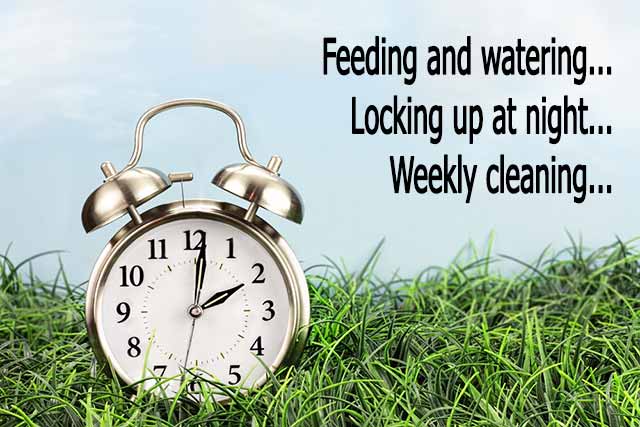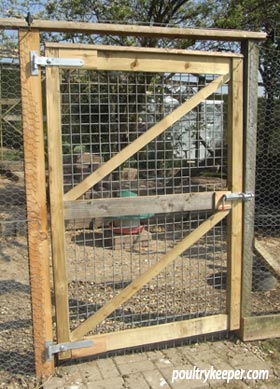Keeping a few chickens in the back yard really is quite straight forward; however there are some things to consider in order to get the right sort of birds for your situation and to keep them in the best possible health to get the most enjoyment out of keeping them.
This page hopes to get you thinking about the types of chickens and their requirements.
Choosing a breed
There are quite literally hundreds of different breeds of chicken to choose from and out of these, many have slightly different requirements.
Some breeds of chicken come only as Large Fowl, and others are also available as Bantams which are a smaller version that look the same. The Orpington for example is available in both large and bantam sizes but the Cochin is only available as large fowl.
There are a handful of ‘True Bantams’ where there is no large fowl equivalent. Examples of these are Dutch Bantams, Japanese Bantams and the popular Pekin Bantam.
Bantams tend to be quite flighty whereas the heavy breeds of large fowl often cannot fly more than a few inches off the ground. Orpingtons for example won’t usually roost very high due to their huge size and will usually just huddle on the floor of the coop.
Every breed is slightly different in the amount of eggs they lay. Typically hens that have been bred for exhibition purposes do not lay as well as utility hens. Bantams of course lay smaller eggs which some people say they prefer for taste.
Hybrids
 Hybrids are chickens that have been created by crossing pure breeds. They are typically crossed to make good layers (the hybrid to the right can lay 280 to 300 eggs!), coloured eggs or attractive hens. Some can be very attractive and they are all generally very hardy. Hybrids are produced in larger numbers that pure breeds and most of the crosses used make the males a different colour as day old chicks so that only females can be raised, therefore reducing costs by about half. A typical hybrid hen will cost you around £15 compare to £25 to £30 for a typical pure breed hen.
Hybrids are chickens that have been created by crossing pure breeds. They are typically crossed to make good layers (the hybrid to the right can lay 280 to 300 eggs!), coloured eggs or attractive hens. Some can be very attractive and they are all generally very hardy. Hybrids are produced in larger numbers that pure breeds and most of the crosses used make the males a different colour as day old chicks so that only females can be raised, therefore reducing costs by about half. A typical hybrid hen will cost you around £15 compare to £25 to £30 for a typical pure breed hen.
Hybrids are a good choice if eggs are one of your priorities although if you think you might like to hatch some eggs, remember hybrid hens do not breed true – you would need the original pure breeds to cross again in order to create more of the same thing so whilst you can hatch their eggs, you may want to consider a few pure breeds for this purpose or consider buying in eggs to hatch.
Free Range
You will of course need a chicken coop but also a secure run or area that is predator proof. A question that people always ask me is “How big should their run be?” I always say “as big as possible within reason.” Even 2 chickens kept in a 2 meter run will soon turn it to mud and get bored (which can introduce vices such as feather pecking and egg eating) but I always believe that it’s fine to provide a small run like this if you can let them out for a few hours each day to free range while you are around. This will give them a chance to forage, supplement their diet and reduce boredom.
Once chickens have settled into their new house, they will go back to it to roost every night so you can let them out in the late afternoon, knowing they will come back to roost at night keeping everyone happy! Some houses and runs have handles or wheels that make them easy to move onto fresh ground which is not only good to prevent a build up of worm eggs and disease but also provides them with a little fresh grass to graze.
Keeping Chickens in the Garden
If you have a ‘nice’ garden that you don’t want spoilt, it’s usually a sensible idea to limit their foraging. Chickens scratch at the ground, make dust baths in the dry soil, leave muck wherever they go and destroy tender young plants. If you can plant in pots, this will help and fencing off part of the garden is usually a good choice to keep them out if you have tender or precious plants. Chickens with feathered feet scratch less and bantams can clear a 6 foot fence if they want to. Heavy breeds of large fowl can be kept out with a knee high fence or box hedge. If you want to stop a bird from flying then you can clip one wing (not both).
So you have decided on the breed that’s right for you and your circumstances. Next, you will need to think about keeping them secure from predators in a suitable chicken house and chicken run – click on a link to go to that page!








We have a large garden that our dog has the run of. We are awaiting delivery of a 13ft long ark so that the chickens will have plenty of space, ideally we would like to let the hens out to roam about. My question is would chicken eat dog poop?
No, you should be fine but it would be advisable to poop pick daily anyway to keep the ground free of dog poop.
Can you keep chickens on concrete?
Their run can be on concrete, providing you give them a deep litter bed of sand or wood chippings to scratch around in and change it periodically.
Do I need to worry about the pond when letting my chickens free range?
Most hens won’t be troubled – but – some may try to drink from it and if they have to lean over the water to take a drink, there have been problems with hens toppling and falling in unintentionally. I have also heard of a hen running to get to the food and running straight into a swimming pool…. so it can happen but on rare occassions.
I live on a council estate, and have heard that there can be noise nuisance with keeping a cockerels. Can you just keep a couple of hens without a cockerel?
Yes, absolutely. There is absolutely no point in keeping a cockerel if he’s going to upset the neighbours. You’ll end up having to get rid of him and upsetting people. Hens will lay just as many eggs without a cockerel.
Firstly your website is very good and extremely useful for the beginner like my self. I have 3 hens at present which are 6 weeks old ,raised from 1 week and was wondering if I can leave them out over night yet or is it still to early. Hope you can point me in the right direction. Steve
Once they are off heat and fully feathered, they can go outside, however it is still quite cold here in the UK at the moment with night time temperatures close to freezing so I would try to provide a little warmth from a 60W light bulb or dull emitter (both securely fixed!) in the coop for them. Coccidiosis usually strikes around 6 weeks, with the stress of changing them to growers pellets and moving them outside with a change in temperature. Make sure bedding is kept dry and clean and try to change feed gradually and a little earlier or later than moving them to reduce the risks.